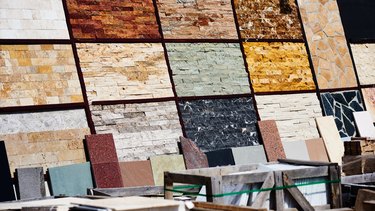
There are many finishes from which to choose when perusing the tile selections that crowd the shelves of interior design and home improvement stores. Polished, glazed, natural and even matte finishes are easily found among the trending tiles filling large and small living spaces in homes across the country. However, honed travertine tile can often confuse a consumer already buried in too much tile information.
Add honed or tumbled travertine as a choice and the head spins. After spending so much time selecting just the right color and shape of the travertine tile you intend to use to make a space shine, take some time to understand the best finish for a fabulous appearance that will last for decades.
Video of the Day
Video of the Day
Benefits of Travertine
Travertine is often chosen for its durability that dovetails nicely with a classic look that will ride out many décor trends over a long period of time. Honed or tumbled travertine tile needs a bit more care than stone floors and backsplashes that have a natural finish. They have a greater risk of getting scratched from shoes, furniture, toys or luggage that is dragged across the floor. The scratch, whether large or small, may be more obvious in a honed or tumbled finish than in a natural finish.
Prevent eyesores from appearing on pristine tile by placing floor protectors under furniture or temporary holiday decorations that rest on the floor. Regular care and maintenance will keep travertine in its top condition for many years. Keeping dirt and dust from the grout and surface of the tile will prolong the life of the stones.
Honed vs. Tumbled Marble
It can be confusing to understand the difference between marble or tile that is honed or tumbled, which can be important depending on how you intend to use the treated product.
When the surface of the stone tile has been ground down to a consistently flat and super smooth texture, it is honed. Naturally shiny stones such as granite and marble are honed when the shine on the surface of the tile is removed and the bits of bumpy texture are completely erased. This leaves the tile with an elegant matte finish that works well as a backdrop in larger bathrooms and kitchens or spaces that have exceptional natural light or gleaming light fixtures.
Honed travertine tile can be filled or unfilled depending on whether you prefer a rougher or smoother surface on the final product. For filled travertine, the natural ridges and holes are filled, while unfilled travertine tile leaves a bit of natural groove in the treated tile. Tumbled tile or marble goes through a process to create the perfectly imperfect surface. This can take a few weeks. The tumbled tile has been roughly spun in a drum to create a naturally worn style that gives a hint of an antique look with its surface imperfections.
Marble or Not Marble
It's a misnomer, albeit a lovely one: Marble tile isn't actually always natural marble. In fact, the ideal stones that are used to create the tiles that are labeled tumbled marble include onyx, quartzite, limestone and travertine. A bit of research should uncover what type of stone was used for the tumbled marble product that has caught your eye. If true tumbled marble is preferred, look for tiles with veins that run through the tiles. Travertine tumbled marble tiles are pocked with holes that give character to each unique piece.